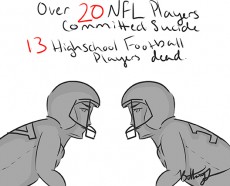Football has been known as the American national pastime for decades. But with the ever-growing evidence that displays football as violent and dangerous, why does it remain such an integral part of society?
In March, San Francisco 49ers linebacker Chris Borland retired at the age of 24. After just one season, Borland left a job that would have potentially earned him $530,000 for the 2015 season. For a 24-year-old to make that kind of money only to walk away from it is seemingly unheard of.

Borland’s reason? He didn’t want the potential of having a brain trauma injury to prevent him from enjoying his life with his family.
The NFL has been marked by over 20 suicides of former players attributed to depression and mental issues brought on by brain damage known as chronic traumatic encephalopathy. CTE is the progressive degeneration of the brain brought on by head trauma, something often unavoidable in football.
The danger football presents goes beyond the NFL, though. On Sept. 4, Louisiana high school football player Tyrell Cameron died after taking a hit during a punt return of a game. On Sept. 25, New Jersey high school quarterback Evan Murray died after leaving the game with an injury.
And just Oct. 17, Texas high school player Cam’ron Matthews died after collapsing on the field during a game.
Cameron, Murray and Matthews aren’t the only ones. According to an article by USA Today, 13 player deaths over the past two years can be directly linked to playing high school football. NBC News reports Matthews as being the sixth high school player to die just this season.
Boys who are strong enough for high-velocity hits don’t have the brain maturity or healing ability to survive those kinds of hits. Despite these alarming deaths, over 1.1 million high schoolers play football every year.
In September, an NBC 5 investigation discovered that the University Interscholastic League was not keeping complete count over the number of concussions occurring in sports in the North Texas area. That’s alarming. What’s even more alarming is to see their count as being 295 concussions when NBC 5 reports the number as being over 2,500.
The statistics are given, and yet there is no sudden outcry or race to make badly needed changes in the sport.
Up until recently, the NFL was bent on denying the existence of a correlation between football and brain damage. Even after allowing that a correlation could exist, the league has been slow to make changes, most recently suspending a pilot program this year that would have used sensors in helmets to study the impact of blows to the head during the game.
This December, Sony will release a highly anticipated movie starring Will Smith, which focuses on the research done by neuropathlogist Bennet Omalu, who discovered the link of CTE in the brain of two NFL players who had committed suicide. This film is a potential nightmare for the
NFL and the sport of football today as it visually plays out what the statistics have revealed for years.
It is almost disturbing, though, that with the deaths and stories of players past through all levels of football, a movie depicting the danger is getting more talk than the reality itself. If the dangers of football continue to be ignored, the consequences will continue to be fatal.
































